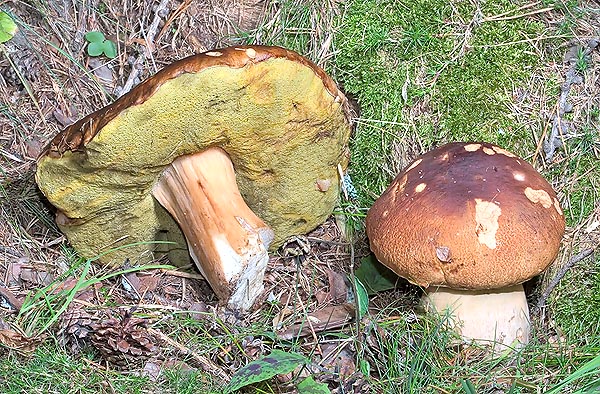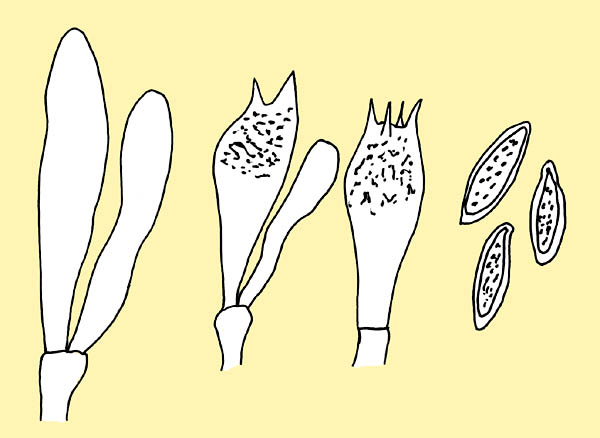
Text © Loredana Battisti

English translation by Mario Beltramini

White, compact flesh. By sure, one of the best mushrooms both raw and cooked © Giuseppe Mazza
Family: Boletaceae Chevalier.
Subfamily: Boletoideae Singer.
Genus: Boletus Dillenius: Fries.
Section: Edules Fries.
Boletus edulis Bulliard : Fries 1821
The name comes from the Latin “edulis” = edible.
The genus Boletus is characterized by mushrooms with hymenophore (structure containing the fertile part of the mushroom, the hymenium, where the reproduction of the spores takes place), formed by tubes and pores which can be easily loosened from the underlying flesh of the cap.
The section Boletus usually gathers sturdy species, with persistently white flesh, stem with a net, the hymenophore shows a white colouring in the young specimen, yellow when ripe, and olive-green when aged (like the colour of the spore print).
Cap: of medium and big size, from 5-20(30) cm, very fleshy, initially hemispheric then convex, finally, flat, sometimes even depressed, almost always viscous-greasy, often wrinkled, cuticle, variable in colour from the beige-light brown-white to the ocherous, always with a thin margin slightly overhanging and generally paler.
Hymenophore: very small tubules, long, free-rounded at the stem, from white to yellow to olive-green with the ripening of the spores, easily detachable from the flesh of the cap, non staining at the cut; small pores concolorous to the tubules, non staining when touched.
Stem: 4-15 x 3-7 cm, fleshy and sturdy, from obese to barrel-shaped, rounded, bulbous, very variable, of light brown colour, in any case very pale; it shows a small white net which extends to the upper part of the stem with a whitish colour, always paler than the colour of the background.
Flesh: white, compact and often in the larger specimen results being dank because imbued with water, of persistently white colour. Fungous smell and taste.

Boletus edulis cystidia, basidia and spores © Pierluigi Angeli
Chemical reactions: cap, flesh and tubules assume a brown colouring with the strong bases such as the KOH (potassium hydroxide) and NaOH (sodium hydroxide); flesh, lilac-pink with IA (ammonium hydroxide); flesh with FeSO4 (ferrous sulphate), F (phenol) – reaction null.
Spores: spindle-shaped, smooth, of size 14,5-17,5 x 4-6 µm.
Habitat: both in latifolious woods, especially beech, and in conifer ones, pines and fir trees; typical hygrophytic species, which loves cool locations, very common in the Alps, less in the Mediterranean zones. The growth happens in summer, till the appearance of the first white frosts.
Edibility: excellent; even raw, if consumed in little quantities.
Notes: Species easily identified mainly due to the wrinkly look of the cap, viscous-greasy with paler margin, and for the white net which extends on the upper half of the stem, always, anyway, paler than the colour of the stem.
Varieties and similar species: close to the type species there are some species or varieties due mainly to the morphologic-chromatic characters and equally edible:
Boletus persoonii Bon = Boletus edulis var. albus (Persoon) Gilbert constantly white coloured.
Boletus venturii Bon = Boletus citrinus Venturi, which holds a cap constantly coloured of yellow.
Remarks : very common mushroom especially in the Alpine zones, it differentiates from the species of the same group for the following characters: Boletus aereus, Boletus aestivalis, prefer a more thermophilic-xerophytic habitat, that is, warm and dry areas; furthermore, the Boletus aestivalis has a net which extends all over the stem, the Boletus aereus shows brown tones and a net brown too.
Boletus phinopilus , which, along with Boletus edulis , completes the group of the “ceps”, is more hygrophytic too, but differentiates for a vinous-reddish colouring and concolorous net.
The Boletus edulis is often found along with the Amanita muscaria, known also as “cep marker” or “spy of the ceps”, as they have the same biological-ecological exigencies.
→ For general notions about Fungi please click here.
→ To appreciate the biodiversity of MUSHROOMS please click here.
